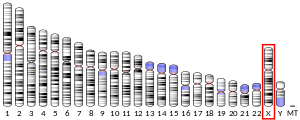MAGEA2
Melanoma-associated antigen 2 is a protein that in humans is encoded by the MAGEA2 gene.[3][4][5]
This gene is a member of the MAGEA gene family. The members of this family encode proteins with 50 to 80% sequence identity to each other. The promoters and first exons of the MAGEA genes show considerable variability, suggesting that the existence of this gene family enables the same function to be expressed under different transcriptional controls. The MAGEA genes are clustered at chromosomal location Xq28. They have been implicated in some hereditary disorders, such as dyskeratosis congenita. This gene has two identical copies at different loci. Alternatively spliced transcript variants encoding the same protein have been identified for this gene.[5]
References
- GRCh38: Ensembl release 89: ENSG00000268606 - Ensembl, May 2017
- "Human PubMed Reference:". National Center for Biotechnology Information, U.S. National Library of Medicine.
- van der Bruggen P, Traversari C, Chomez P, Lurquin C, De Plaen E, Van den Eynde B, Knuth A, Boon T (Jan 1992). "A gene encoding an antigen recognized by cytolytic T lymphocytes on a human melanoma". Science. 254 (5038): 1643–7. doi:10.1126/science.1840703. PMID 1840703.
- Rogner UC, Wilke K, Steck E, Korn B, Poustka A (Mar 1996). "The melanoma antigen gene (MAGE) family is clustered in the chromosomal band Xq28". Genomics. 29 (3): 725–31. doi:10.1006/geno.1995.9945. PMID 8575766.
- "Entrez Gene: MAGEA2 melanoma antigen family A, 2".
Further reading
- Brasseur F, Rimoldi D, Liénard D, et al. (1995). "Expression of MAGE genes in primary and metastatic cutaneous melanoma". Int. J. Cancer. 63 (3): 375–80. doi:10.1002/ijc.2910630313. PMID 7591235.
- De Plaen E, Arden K, Traversari C, et al. (1994). "Structure, chromosomal localization, and expression of 12 genes of the MAGE family". Immunogenetics. 40 (5): 360–9. doi:10.1007/BF01246677. PMID 7927540.
- Gaugler B, Van den Eynde B, van der Bruggen P, et al. (1994). "Human gene MAGE-3 codes for an antigen recognized on a melanoma by autologous cytolytic T lymphocytes". J. Exp. Med. 179 (3): 921–30. doi:10.1084/jem.179.3.921. PMC 2191409. PMID 8113684.
- De Smet C, Lurquin C, van der Bruggen P, et al. (1994). "Sequence and expression pattern of the human MAGE2 gene". Immunogenetics. 39 (2): 121–9. doi:10.1007/bf00188615. PMID 8276455.
- Zakut R, Topalian SL, Kawakami Y, et al. (1993). "Differential expression of MAGE-1, -2, and -3 messenger RNA in transformed and normal human cell lines". Cancer Res. 53 (1): 5–8. PMID 8416750.
- Mallon AM, Platzer M, Bate R, et al. (2000). "Comparative genome sequence analysis of the Bpa/Str region in mouse and Man". Genome Res. 10 (6): 758–75. doi:10.1101/gr.10.6.758. PMC 310879. PMID 10854409.
- Strausberg RL, Feingold EA, Grouse LH, et al. (2003). "Generation and initial analysis of more than 15,000 full-length human and mouse cDNA sequences". Proc. Natl. Acad. Sci. U.S.A. 99 (26): 16899–903. doi:10.1073/pnas.242603899. PMC 139241. PMID 12477932.
- Nagao T, Higashitsuji H, Nonoguchi K, et al. (2003). "MAGE-A4 interacts with the liver oncoprotein gankyrin and suppresses its tumorigenic activity". J. Biol. Chem. 278 (12): 10668–74. doi:10.1074/jbc.M206104200. PMID 12525503.
- Gerhard DS, Wagner L, Feingold EA, et al. (2004). "The status, quality, and expansion of the NIH full-length cDNA project: the Mammalian Gene Collection (MGC)". Genome Res. 14 (10B): 2121–7. doi:10.1101/gr.2596504. PMC 528928. PMID 15489334.
- Monte M, Simonatto M, Peche LY, et al. (2006). "MAGE-A tumor antigens target p53 transactivation function through histone deacetylase recruitment and confer resistance to chemotherapeutic agents". Proc. Natl. Acad. Sci. U.S.A. 103 (30): 11160–5. doi:10.1073/pnas.0510834103. PMC 1544058. PMID 16847267.
- Wischnewski F, Friese O, Pantel K, Schwarzenbach H (2007). "Methyl-CpG binding domain proteins and their involvement in the regulation of the MAGE-A1, MAGE-A2, MAGE-A3, and MAGE-A12 gene promoters". Mol. Cancer Res. 5 (7): 749–59. doi:10.1158/1541-7786.MCR-06-0364. PMID 17634428.

